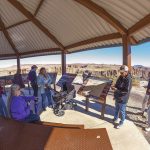
Yazzie asks Nez to press Biden for new GIMC
WINDOW ROCK
After President Jonathan Nez gave the state of the Navajo Nation address during the spring session, Delegate Edmund Yazzie requested that Nez inform first lady Jill Biden of the need for a new Gallup Indian Medical Center to be built when she visits the Navajo Nation today and Friday.
In Nez’s address much was discussed including the Indian Health Service, COVID-19, the Radiation Exposure Compensation Act, infrastructure projects and the American Relief Plan Act.
But what wasn’t discussed, until Yazzie brought it up, was the need for a new Gallup hospital to replace the current aged hospital.
“We’re drafting a letter since the first lady is coming to the Navajo Nation … it will be hand-carried,” said Yazzie to Nez, who also referred to legislation promoting a new hospital in Rehoboth.
“I need your help with the IHS hospital,” Yazzie said. “Let’s not wait until the virus goes up. I hope this letter reaches out to her saying we need to get on this ASAP.”
In response, Nez said his office had a discussion with the IHS Facility Advisory Appropriation Board. He explained other projects located in Pueblo Pintado, Bodaway-Gap, Dilkon, as well as GIMC are still on an old list of infrastructure needs.
They will soon develop a new list that will include the Tuba City Regional Health Care’s oncology center and new facilities at Chinle and Shiprock, Nez said.
“For Gallup Indian Medical Center we all recognize the land – we don’t have land owned by the Nation,” said Nez. “It seems like we are talking about Rehoboth right now, but they still own the land.
“Until the land belongs to the Nation we can’t move forward,” he said. “Discussion of economic development should be put into the discussion as well.”
Nez continued to say until site evaluations are done they can’t go forward with building a new GIMC. He also noted land in Gamerco has been considered, but nothing has been determined.
As the Nation continues to drag its feet in purchasing land for a much-needed hospital, GIMC, which was built in the 1950s, continues to age and become a safety hazard.
Also in the address, Nez said he recommended current Navajo Area IHS Director Roselyn Tso be considered to lead the entire Indian Health Service.
Tso has worked for IHS since 1987 in several different capacities with several different regions.
Nez met not only with Interior Secretary Deb Haaland, but also Secretary of Transportation Pete Buttigieg and Deputy Assistant Secretary for Tribal Affairs Arlando Teller, to discuss the Nez-Lizer administration’s transportation white paper.
The paper, titled, “Diné Atiin Bahane: Navajo Road Emergence,” requests the federal government to enact seven policy changes to improve the Navajo Nation’s transportation system.
The white paper includes:
- Resolve conflicts in agency authority and jurisdictions in order to protect people, the environment, and indigenous cultural resources;
- Harmonize agency guidance with federal law to make Diné roads safe;
- Provide flexibility to the Tribal Priority Allocations that the BIA uses for road maintenance so that TPA funds ?may also be used to fund tribal roads;
- Ensure agency practices are consistent with policies to make the Navajo road system equitable;
- Protect the integrity of tribal roads funds so that they do not subsidize non-tribal roads;
- Recognize that tribal bridges and roads present different circumstance that require complementary, ?not competitive funding sources; and
- Promote tribal sovereignty by retroceding secretarial approval over tribes who have demonstrated their own ?capacity for federal regulatory compliance.?
Like Yazzie, Delegate Kee Allen Begay asked how he can submit a formal statement to Biden when it comes to uranium mine cleanup in Tachee/Blue Gap. Nez stated delegates will be able to give Biden a letter, should they want to.
Within Nez’s address, he said the Nez-Lizer administration continues to advocate for amendments to RECA in support of Navajo people who continue to experience long-term health impacts due to radioactive contamination and exposure from abandoned uranium mines.
The administration also opposes the U.S. Nuclear Regulatory Commission’s draft environmental impact statement that proposes to transfer uranium waste from the Northeast Church Rock abandoned mine site to another site located very close to Navajo Nation trust lands.
Regarding the $20 billion for tribal nations from the American Rescue Plan, there will be an additional $6 billion for the IHS, $1.2 billion for HUD tribal and Native Hawaiian housing programs, $1.1 billion for educational programs including the Bureau of Indian Education, over $1 billion for tribal child-care programs and $75 million for tribal Temporary Assistance for Needy Families, $900 million for Bureau of Indian Affairs programs, $600 million for economic and infrastructure investments, $20 million to mitigate the impact on Native languages, and $19 million to help combat domestic violence.
Nez said, “We will continue to work together with the 24th Navajo Nation Council, Judicial Branch, and many others to put forth a collaborative plan that includes the general priorities related to direct relief, infrastructure development, economic recovery, housing, long-term planning, mental health, and more.”








 Highway 264,
Highway 264, I-40, WB @ Winslow
I-40, WB @ Winslow